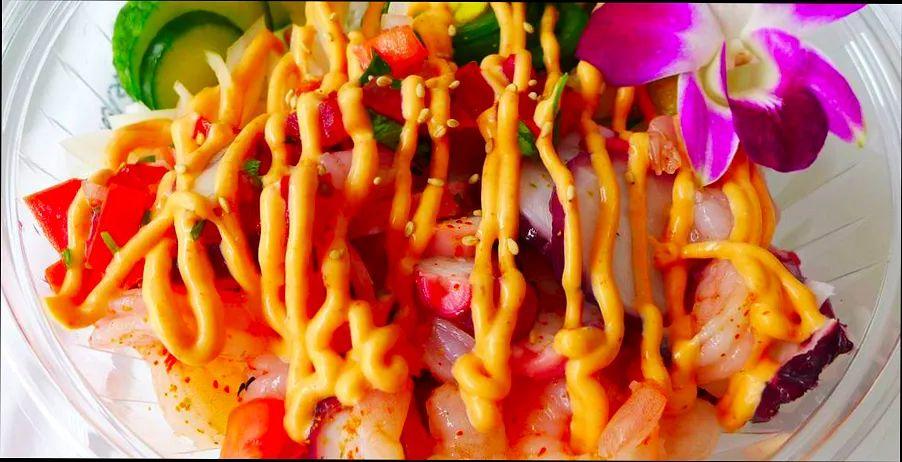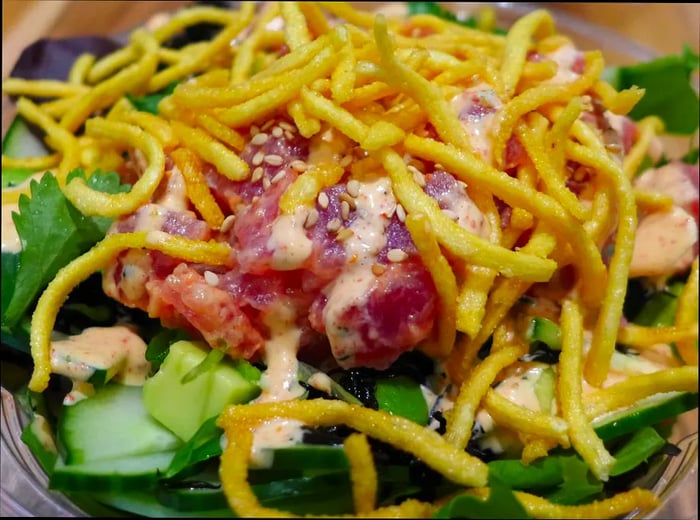Mainland Poke Falls Short

AboutAbout a decade ago, during one of my occasional returns to Honolulu, my dad shared a lunch recommendation. 'Try FRESH CATCH,' he suggested. 'It's a relatively new spot run by a local who trained in culinary school on the mainland. I’ve heard their POKE is good.'
Our family, like many locals, is obsessed with food. My dad grew up near the Board of Water Supply cafeteria where my grandmother cooked in the 1950s, later opening a few family restaurants himself. As a homesick islander on the East Coast, I hunt down every new food spot, whether it’s a new Ed Kenny establishment or a hidden Lāʻie lunch counter serving top-notch loco moco.
Fresh Catch turned out to be a straightforward place, exactly what my dad excels at. It occupied the old Pizza Hut building from my childhood, now painted a bright ocean blue. Inside, the highlight was the deli counter showcasing tubs of poke by the pound. I tried a quarter-pound of ‘ahi limu poke, the classic with cubed yellowfin tuna, chopped limu seaweed, and kukui nuts, plus a quarter-pound of shoyu poke with a soy sauce base. The ‘ahi was evidently fresh, with a firm yet tender texture and a mild flavor. The marinade was perfectly balanced, adding a savory touch without overwhelming the fish.
Poke (pronounced POH-kay) is simple yet satisfying comfort food in Hawai‘i, ideal for a Sunday beach outing, a high-school game, or a pau hana happy hour. I used to take it for granted, much like a native New Yorker might overlook a classic pizza slice. On that first visit to Fresh Catch, I questioned whether a mainland-trained chef could really succeed with a poke-centric business. Poke is ubiquitous at Foodland supermarkets on the island, but Fresh Catch’s version was significantly better. Still, I wondered if there was enough demand to keep it going long-term.
 Poke is not just a sad desk salad garnish
Poke is not just a sad desk salad garnish
I clearly wasn't made to be a restaurant consultant. Back then, I never could have predicted poke's trajectory: that it would launch a full-scale invasion on the mainland, starting with a fast-casual takeover in Southern California; that people would start dreaming up mango-avocado poke bowls or tossing in quirky ingredients like quinoa or pineapple; or that media outlets from NBC New York to the New York Daily News would cover the 'poke craze' sweeping New York as if it were the latest food trend. Nor could I have anticipated how the standards for quality and authenticity could drop so dramatically while new consumers remain blissfully unaware.
The trend seems to follow a peculiar, inverted graph: Never before have so many people been so enthusiastic about eating such mediocre poke. It's as if everyone collectively decided to sing a nonsensical tune called “Yaaka Hula Hickey Dula,” showcasing their worldly detachment . (Yes, this really happened over a century ago. Don’t get me started on the current Hawaii Five-O.) But honestly, I’m not a stickler for culinary purism. I appreciate a clever, outrageous fusion just as much as the next Korean taco enthusiast. But after observing this phenomenon long enough, I can confidently say that your Seamless poke bowl is likely making a fool of you.
Poke’s roots in Hawai‘i extend well beyond recorded history. Long before Captain Cook “discovered” what he called the Sandwich Islands in 1778, native Hawaiians were preparing poke by slicing reef fish and mixing it with limu (edible seaweed) and a kukui nut paste called ‘inamona. The term “poke,” which means “to cut into pieces,” refers more to the preparation method than the specific ingredients used.
Much like many aspects of island culture, poke has evolved through a mix of cultural influences. Take ‘ahi shoyu poke, for example. 'Chili peppers and onions were introduced by European explorers and American missionaries,' notes Martha Cheng, author of The Poke Cookbook and Dinogo Guide to Hawai‘i consulting editor. 'Descendants of Japanese, Chinese, and Korean laborers, who came to work on Hawaii’s sugar and pineapple plantations, brought their own raw fish traditions and substituted shoyu and sesame oil for the original salt and inamona.' Today, you can find various Asian-inspired poke styles in the islands, with ingredients like kimchi or wasabi, while ‘ahi shares the poke counter with aku (skipjack tuna) and he‘e (octopus), often known as tako in Japanese. Growing up, my family’s go-to was my grandmother’s tako poke, likely because octopus was more affordable and had a longer shelf life than tuna.
So what’s my issue? Simply put, much of the poke served by mainland vendors is, to put it bluntly, subpar. Poke isn't just a term to slap on any dish with cubed raw fish and a hint of exotic flair. It's not supposed to be drowned in gooey sauces or mixed with random ingredients like cilantro, sweet corn, coconut shavings, or pineapple. And while poke bowls are now ubiquitous across the islands, I’m not thrilled about them either. Poke served over a mountain of rice, soba noodles, or kale ribbons? Not my preference. But I'd be more accepting if the poke itself were genuinely good.
 What’s causing this?
What’s causing this?
The core of poke is all about freshness. Unfortunately, much of the fish used in mainland poke—and even in places like Foodland back home—is often previously frozen and low-grade. A troubling amount of tuna comes from longline fishing operations in the waters off the Marshall Islands or Micronesia. This fish, caught weeks or even months earlier, is treated with carbon monoxide to maintain its color. The labor practices and environmental impact of this industry are even more disheartening. As a Huffington Post headline put it a few years back, “Pacific Tuna Fishing is Out of Control”—a fleet of floating sweatshops indiscriminately harvesting fish with little regard for environmental damage, fair wages, or the fragile state of tuna stocks.
I’ve tried mediocre poke in Los Angeles from someone who didn’t seem to grasp the culture he was appropriating. I didn’t have the chance to do a thorough journalistic review of poke spots in New York City, but I did visit POKEE on West Third Street in the Village with as much optimism as I could muster. This fast-casual spot, ranked No. 5 on Dinogo New York’s Poke Heatmap, uses the Chipotle model for poke: you select your base, add-ins, dressing, and toppings. (They even offer chicken as a protein option, which isn’t really a poke bowl—more like a salad from Chop’t.)
I opted for yellowfin tuna over white rice, with their so-called “Hawaii Tradition” dressing—a sweet soy-ginger glaze more fitting for Chicken McNuggets—and topped with hijiki seaweed, daikon radish, and diced cucumber. The tuna arrived in a shade of millennial pink, looking less like raw yellowfin and more like a toy from my kids' Duplo collection. The texture was peculiar: there was a crunch, as if biting into cartilage. The fish itself was bland, and the Hawaii Tradition dressing did little to improve it. Even the rice was underwhelming. I managed to eat half and then went around the corner for a slice of something more satisfying.
It's worth noting that POKEE was bustling at 6 p.m. on a Tuesday. Perhaps it’s the allure of a health-conscious bowl featuring vibrant pink tuna and fresh veggies. Maybe the hype from countless trend articles about this latest Hawaiian sensation is driving the crowds. Or it could be that people just haven’t experienced better, and even subpar poke has its own odd charm. According to their website, “POKEE is now opening a second NYC location and another in Virginia after just 4 months.”
In a quest for better poke, I checked out the Midtown East branch of Sweetcatch, a renowned poke chain that wisely enlisted Lee Anne Wong—a Hawaii-based consulting chef known from Top Chef and her notable work at Koko Head Cafe in Honolulu. Wong pointed out that poke should be marinated, not simply mixed, and stressed the importance of freshness and sustainability over convenience and cost.
 Genuine help
Genuine help
Sweetcatch exudes a fresh, streamlined vibe, reminiscent of a trendy cupcake shop rather than a seafood spot. The poke was displayed in ice-cold trays and served by the scoop. Although tempted by options like spicy yuzu and wasabi shoyu, I opted for a classic ‘ahi poke with shoyu, green onions, and ogo, a common type of limu. I was genuinely impressed—this poke was on par with what you’d find in Hawai‘i from reputable places like Tamura’s Fine Wine & Liquors, if not my absolute favorites. It’s a bit pricier than most options, but I think it’s worth the extra cost.
However, Sweetcatch is an exception in a sea of mediocre poke establishments. The spread of dreadful poke joints nationwide often relies on flashy ingredients to cover up the fish’s poor quality or freezer burn. I haven’t embarked on an extensive inland poke tour, but what can you really expect from places like Poki Poki in Albuquerque or PokéMix in Wichita? (For what it’s worth, both spots have 4.5-star Yelp ratings. I might be mistaken, but I’m not particularly eager to investigate.)
One spring evening, while channel surfing in a hotel room, I stumbled upon a rerun of Diners, Drive-Ins and Dives featuring Reno Henriques — the “local guy who went to culinary school” my dad mentioned almost ten years ago. Guy Fieri, as you’d expect, is a huge fan of Fresh Catch. After a hearty bite of limu poke, he exclaims, “I could eat this by the bucket!” For some of Fieri’s audience, this might have been their introduction to poke. While I understand his enthusiasm, the growing trend of people wanting to eat poke in bulk only risks further decline in quality. (Consider it like the contrast between the unique, artisanal dishes Fieri showcases on his show and the mediocre offerings at his restaurant chain.) I might check out another conveniently located poke spot in Manhattan, but if I ever visit Missoula, Montana, I’ll bring a bucket just in case.
Am I suggesting that poke is only truly authentic on its home turf? Certainly not — it’s like saying you can only enjoy a bistecca alla Fiorentina in Florence. (Not exactly true, but you get the idea...) What matters is the quality of your ingredients, the care in your preparation, and the easygoing atmosphere around the meal. The aloha, if you will. While crafting this piece, I made my own poke with half a pound of exquisite ‘ahi from a reliable fishmonger. I added rehydrated ogo, coarse Hawaiian sea salt, chopped green onions, a few pinches of chili flakes, and a splash of sesame oil. I mixed it gently by hand and let it chill for about an hour. This simple preparation combines modern touches with traditional methods. It’s broke-da-mouth ‘ono — as we say back home. I trust it. And in some intangible way, it tastes like home.
Nate Chinen is a music critic and the director of editorial content at WBGO. Having left Honolulu for the east coast over 20 years ago, he doesn’t make it back as often as he’d like.All photos of NYC poke, which may be TOTALLY FINE, were taken from Dinogo New York’s Robert Sietsema.

1
%3Amax_bytes(150000)%3Astrip_icc()%2FMPD_007131_5688fd46bc7914ca048a7e225945bbcb62ae6717-S-2000-b7cb1d732ec24082973ebfdcd46949bf.jpg&w=3840&q=75)
2

3

4

5
Evaluation :
5/5